Profile configuration in the Networks tab
Last adaption: 02.2023
notemptyThis article refers to a Resellerpreview
Partial configuration for profiles in the Mobile Security Portal.
Further information is displayed here:
Networks
Networks
In this section, access profiles for WiFi networks can be configured and pushed to the device.
Add a network configuration with
Network configurations
|
|
|
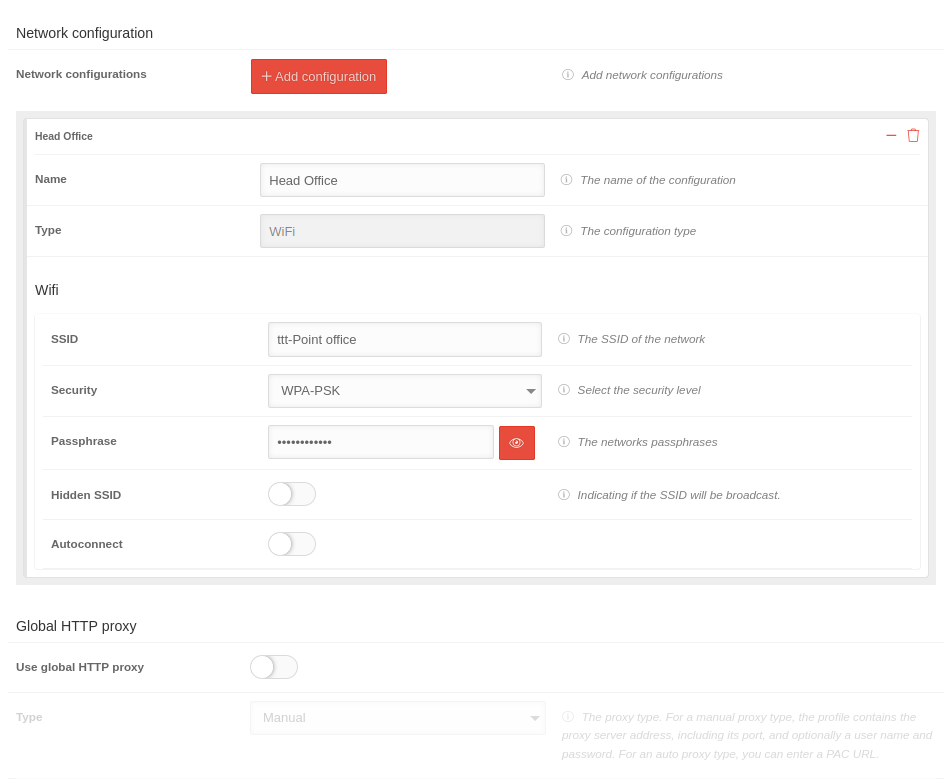 Network configurations
|
| Name |
Name |
Name of the configuration
|
| Type |
WiFi |
Configuration type (WiFi predefined)
|
| SSID |
SSID |
The SSID of the network
|
| Security |
|
Security level of the network key
|
| None |
No security
|
| WEP-PSK |
Insecure
|
| WPA-PSK |
Secure
|
| Password |
Password |
The networks passphrases. Hidden with placeholders.
shows the password in plain text.
|
| Hidden SSID |
|
Specifies whether the SSID of the network is visible or hidden .
|
| Autoconnect |
|
Enable for the device to automatically connect to the network.
|
| Deaktiviere MAC Randomisierung |
|
Bei Aktivierung identifizieren sich die Geräte stets mit der gleichen MAC-Adresse in einem Netzerk. Kann vom Benutzer nicht geändert werden. Diese Funktion zeigt auch eine Datenschutzwarnung in den Einstellungen an, dass das Netzwerk einen eingeschränkten Datenschutz hat.
Dieser Wert wird nur gesperrt, wenn das Profil über ein MDM installiert wird.
Wird der Wert z.B. mit dem Apple Configurator 2 festgelegt, kann er vom Benutzer geändert werden. |
EAP-Client / WPA2 Enterprise
|
| Use EAP Client |
|
When activated, the EAP client, the WPA2 Enterprise can be used
|

|
| EAp Types |
Select EAP Types |
The EAP type is selected. Several types can be selected.
The choices are:
|
|
|
| Payload Certificate Anchor UUID |
|
The certificate that is handed to the server by the client as authentication when logging on to the WLAN. Apple: An array of the UUID of a certificate payload to trust for authentication |
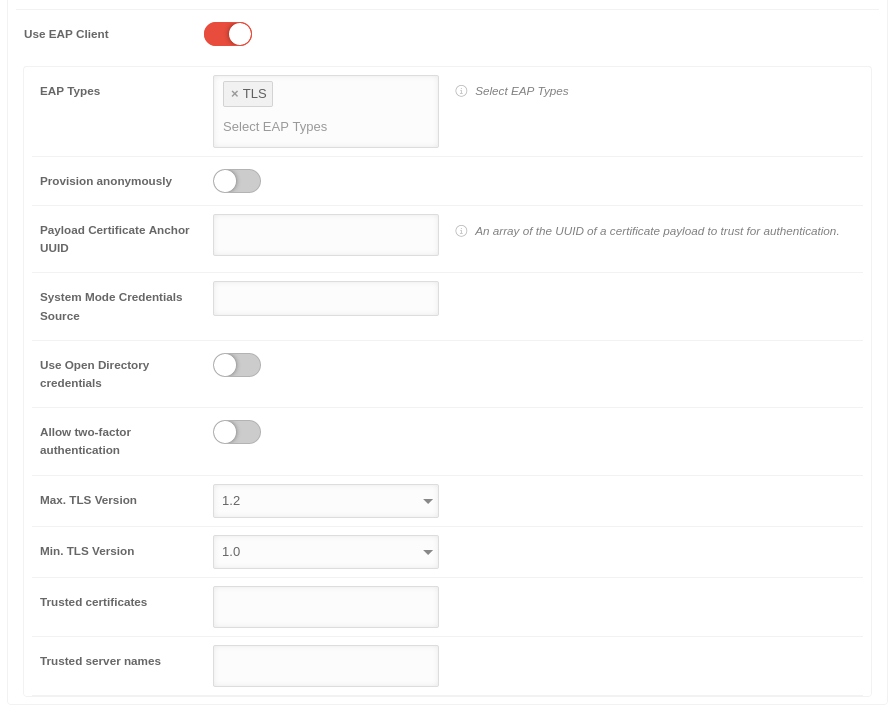
|
| System Mode Credentials Source |
|
The server for the system mode credentials
|
| Use Open Directory credentials |
|
When activated, logging in through Open Directory is possible
|
| Allow two-factor authentication |
|
Two-factor authentication is possible when activated
|
| Max. TLS Version |
1.2
default |
The maximum TLS version is selected.
The choice is:
|
| Min. TLS Version |
1.0
default |
The minimum TLS version is selected.
The choice is:
|
| Trusted certificates |
|
The certificates that are to be trusted are entered
|
| Trusted server names |
|
The names of the servers that are to be trusted are entered
|
| One time user password |
|
If activated, the user will be prompted to enter the password each time they connect
|
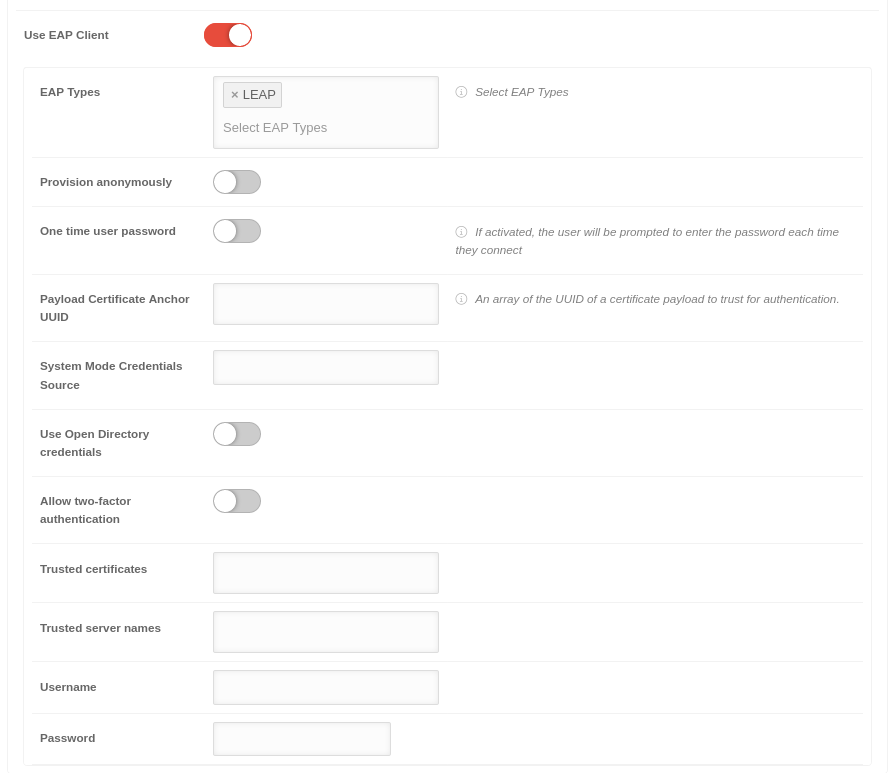
|
| Payload Certificate Anchor UUID |
|
The certificate that is handed to the server by the client as authentication when logging on to the WLAN. Apple: An array of the UUID of a certificate payload to trust for authentication |
| System Mode Credentials Source |
|
The server for the system mode credentials
|
| Use Open Directory credentials |
|
When activated, logging in through Open Directory is possible
|
| Allow two-factor authentication |
|
Two-factor authentication is possible when activated
|
| Trusted certificates |
|
The certificates that are to be trusted are entered
|
| Trusted server names |
|
The names of the servers that are to be trusted are entered
|
| Username |
|
Username of the account for the server
|
| Password |
|
Password of the account for the server
|
| EAP SIM Number Of RANDs |
3
default |
The number of EAP SIMs of the RANDs is selected
|
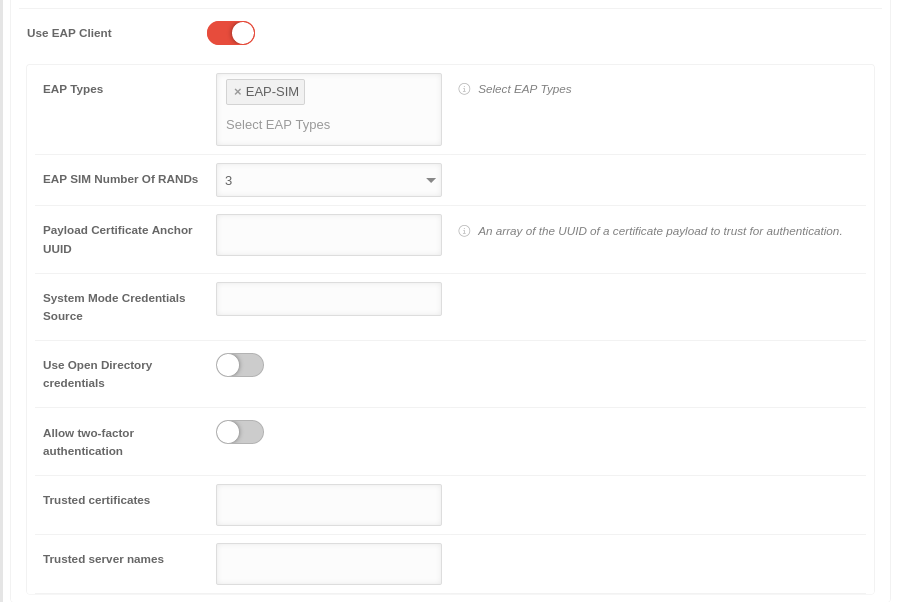
|
| Payload Certificate Anchor UUID |
|
The certificate that is handed to the server by the client as authentication when logging on to the WLAN. Apple: An array of the UUID of a certificate payload to trust for authentication |
| System Mode Credentials Source |
|
The server for the system mode credentials
|
| Use Open Directory credentials |
|
When activated, logging in through Open Directory is possible
|
| Allow two-factor authentication |
|
Two-factor authentication is possible when activated
|
| Trusted certificates |
|
The certificates that are to be trusted are entered
|
| Trusted server names |
|
The names of the servers that are to be trusted are entered
|
| One time user password |
|
If activated, the user will be prompted to enter the password each time they connect
|
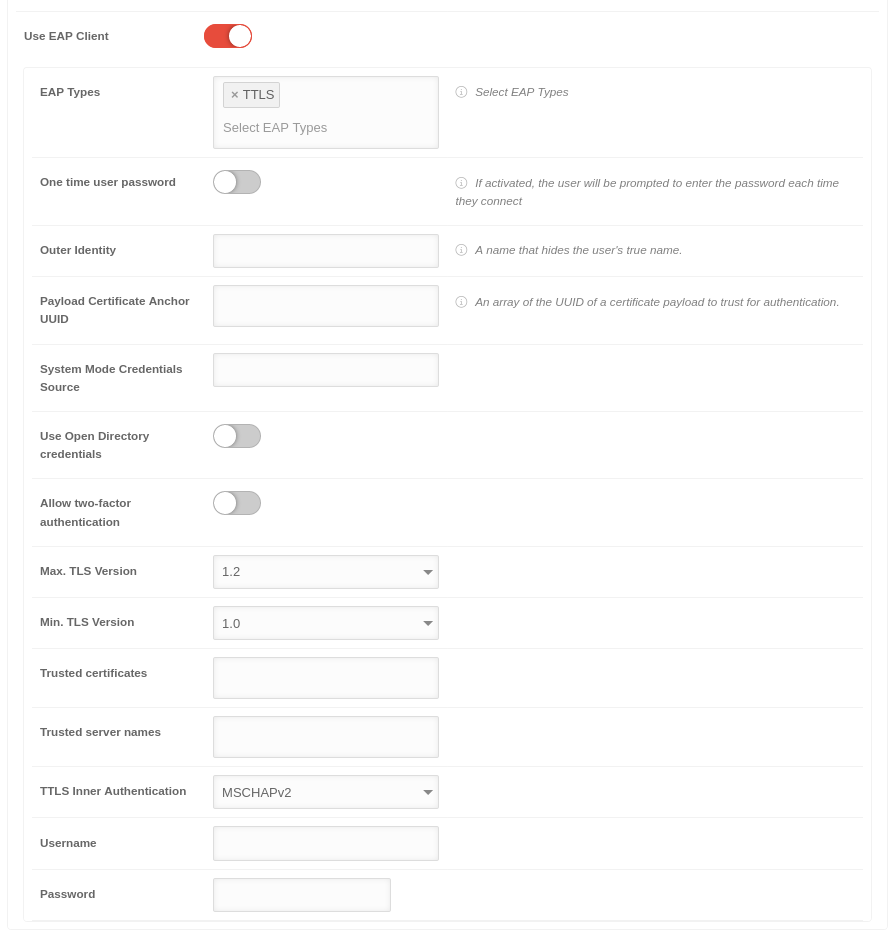
|
| Outer Identity |
|
A name that hides the user's true name
|
| Payload Certificate Anchor UUID |
|
The certificate that is handed to the server by the client as authentication when logging on to the WLAN. Apple: An array of the UUID of a certificate payload to trust for authentication |
| System Mode Credentials Source |
|
The server for the system mode credentials
|
| Use Open Directory credentials |
|
When activated, logging in through Open Directory is possible
|
| Allow two-factor authentication |
|
Two-factor authentication is possible when activated
|
| Max. TLS Version |
1.2
default |
The maximum TLS version is selected.
The choice is:
|
| Min. TLS Version |
1.0
default |
The minimum TLS version is selected.
The choice is:
|
| Trusted certificates |
|
The certificates that are to be trusted are entered
|
| Trusted server names |
|
The names of the servers that are to be trusted are entered
|
| TTLS Inner Authentication |
MSCHAPv2 |
The inner authentication of TTLS is selected.
The choices are:
- PAP
- EAP
- CHAP
- MSCHAP
- MSCHAPv2
|
| Username |
|
Username of the account for the server
|
| Password |
|
Password of the account for the server
|
| Payload Certificate Anchor UUID |
|
The certificate that is handed to the server by the client as authentication when logging on to the WLAN. Apple: An array of the UUID of a certificate payload to trust for authentication |
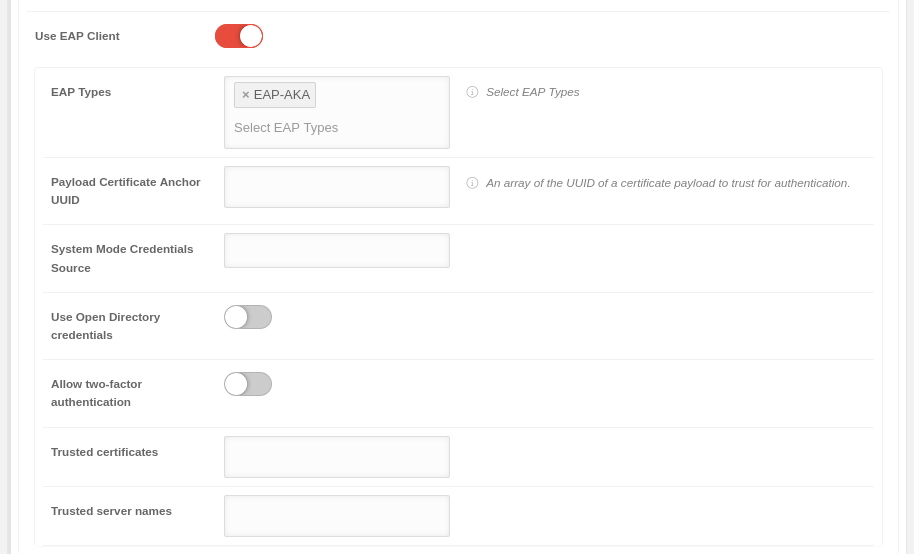
|
| System Mode Credentials Source |
|
The server for the system mode credentials
|
| Use Open Directory credentials |
|
When activated, logging in through Open Directory is possible
|
| Allow two-factor authentication |
|
Two-factor authentication is possible when activated
|
| Trusted certificates |
|
The certificates that are to be trusted are entered
|
| Trusted server names |
|
The names of the servers that are to be trusted are entered
|
| One time user password |
|
If activated, the user will be prompted to enter the password each time they connect
|
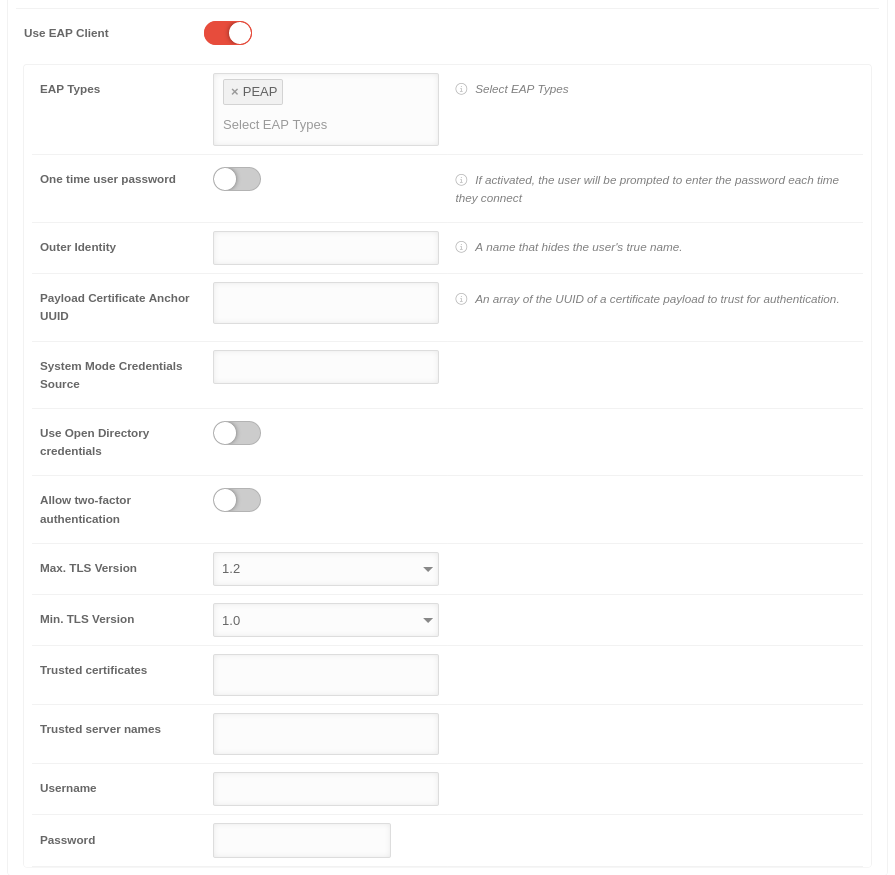
|
| Outer Identity |
|
A name that hides the user's true name
|
| Payload Certificate Anchor UUID |
|
The certificate that is handed to the server by the client as authentication when logging on to the WLAN. Apple: An array of the UUID of a certificate payload to trust for authentication |
| System Mode Credentials Source |
|
The server for the system mode credentials
|
| Use Open Directory credentials |
|
When activated, logging in through Open Directory is possible
|
| Allow two-factor authentication |
|
Two-factor authentication is possible when activated
|
| Max. TLS Version |
1.2
default |
The maximum TLS version is selected.
The choice is:
|
| Min. TLS Version |
1.0
default |
The minimum TLS version is selected.
The choice is:
|
| Trusted certificates |
|
The certificates that are to be trusted are entered
|
| Trusted server names |
|
The names of the servers that are to be trusted are entered
|
| Username |
|
Username of the account for the server
|
| Password |
|
Password of the account for the server
|
| Provision PAC |
|
PAC bereitstellen
|
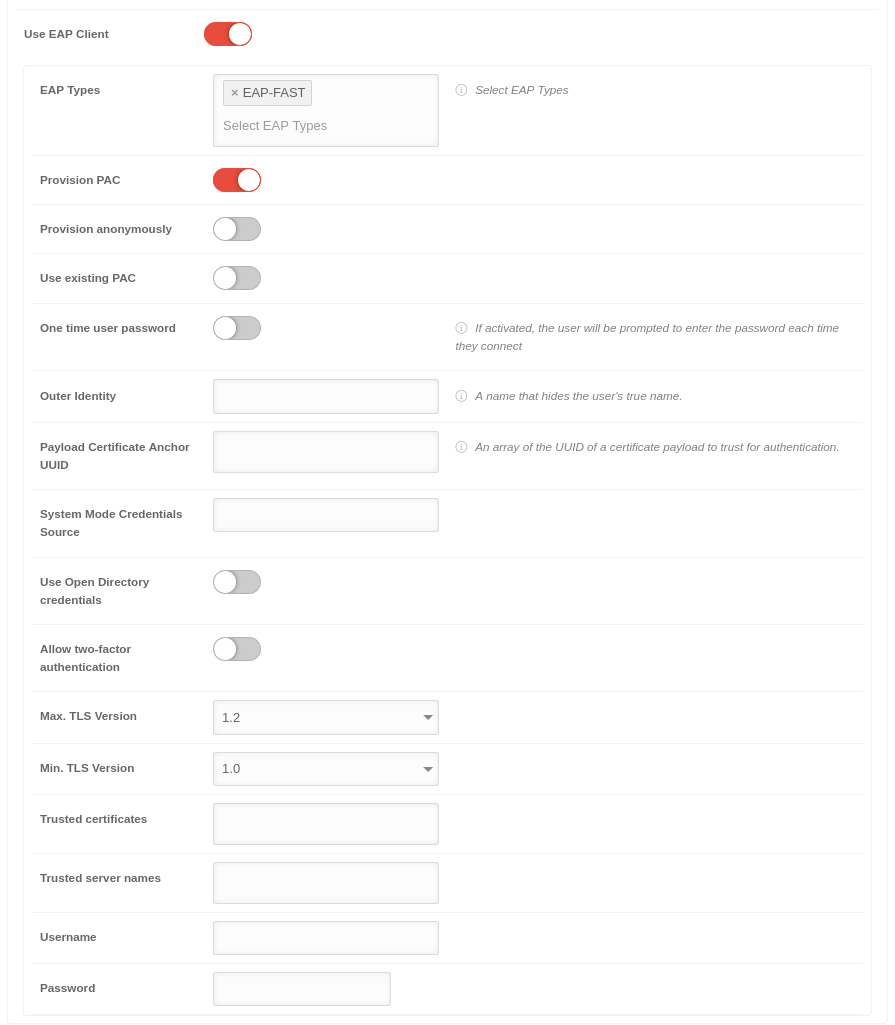
|
Provision anonymously
Displayed when Provision PAC is activated. |
|
Anonym bereitstellen
|
| Use existing PAC |
|
Vorhandene PAC verwenden
|
| One time user password |
|
If activated, the user will be prompted to enter the password each time they connect
|
| Outer Identity |
|
A name that hides the user's true name
|
| Payload Certificate Anchor UUID |
|
The certificate that is handed to the server by the client as authentication when logging on to the WLAN. Apple: An array of the UUID of a certificate payload to trust for authentication |
| System Mode Credentials Source |
|
The server for the system mode credentials
|
| Use Open Directory credentials |
|
When activated, logging in through Open Directory is possible
|
| Allow two-factor authentication |
|
Two-factor authentication is possible when activated
|
| Max. TLS Version |
1.2
default |
The maximum TLS version is selected.
The choice is:
|
| Min. TLS Version |
1.0
default |
The minimum TLS version is selected.
The choice is:
|
| Trusted certificates |
|
The certificates that are to be trusted are entered
|
| Trusted server names |
|
The names of the servers that are to be trusted are entered
|
| Username |
|
Username of the account for the server
|
| Password |
|
Password of the account for the server
|
|
Global HTTP proxy
A Global HTTP proxy can be configured, for example, if devices are permanently on the same network and a local proxy is to be used on the device.
Especially recommended for devices that only have an MDM license. These can then use, for example, the protection functions of a Securepoint UTM with web filter, etc.
|
| Use global HTTP proxy |
|
Activates the global HTTP proxy
|
| Type |
Manual
Automatic |
For a manual proxy type, the profile contains the proxy server address, including the port, and optionally a user name and password. For an auto proxy type, you can enter a PAC URL.
|
| Allow captive login |
|
When active, the device can bypass the proxy server to display the login page for networks with a captive portal
|
| Username |
Username |
The username used to authenticate to the proxy server
|
| Password |
Password |
The password used for authentication to the proxy server
|
| Server |
Server |
The network address of the proxy server
|
| Server port |
8080 |
The port used to connect to the proxy server
|








